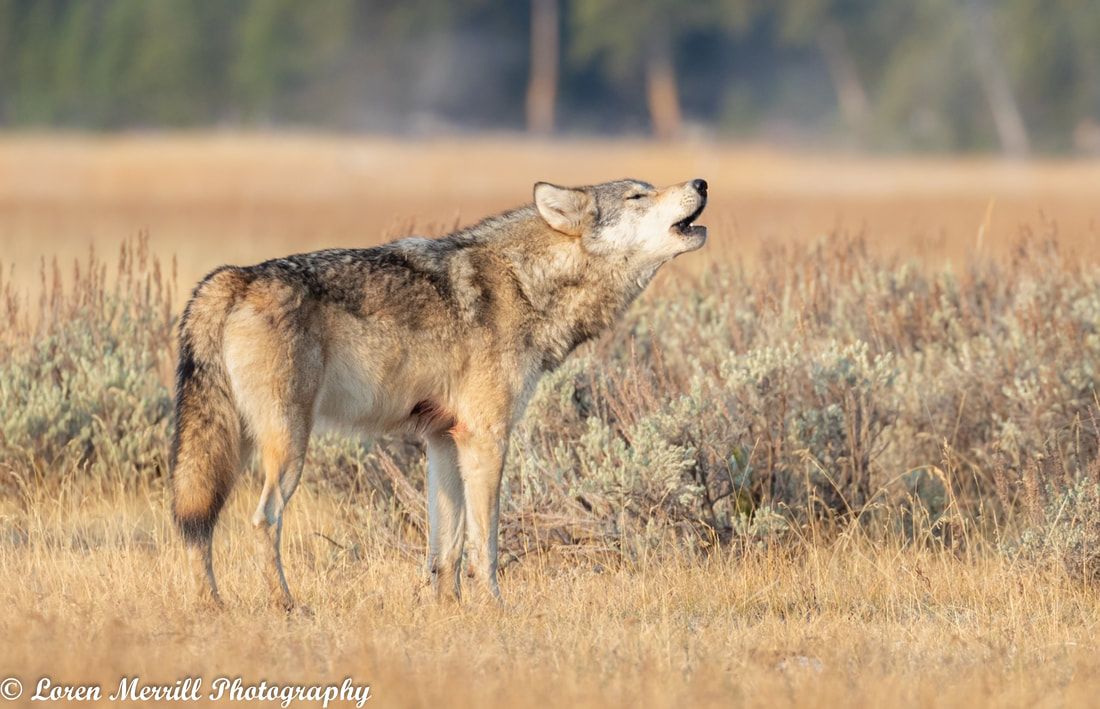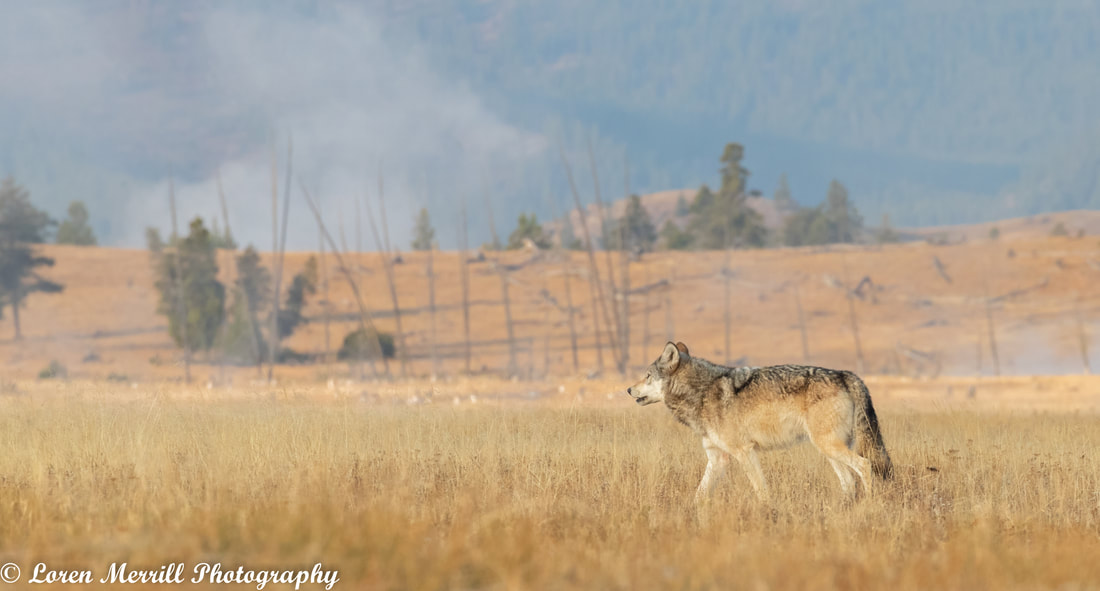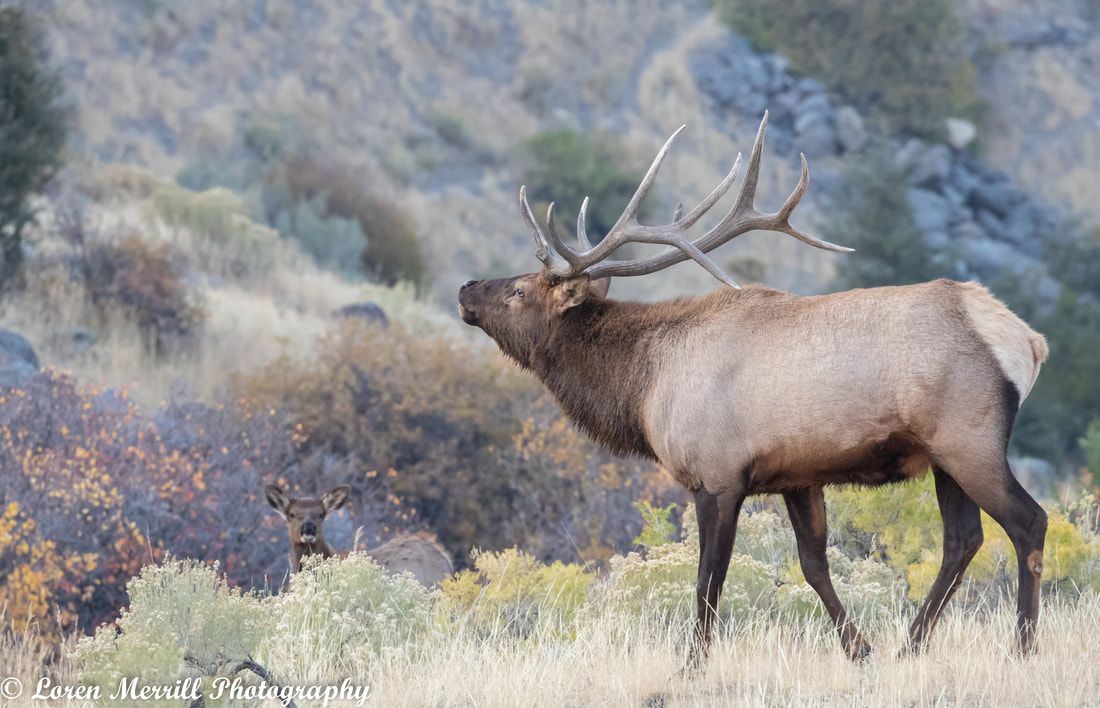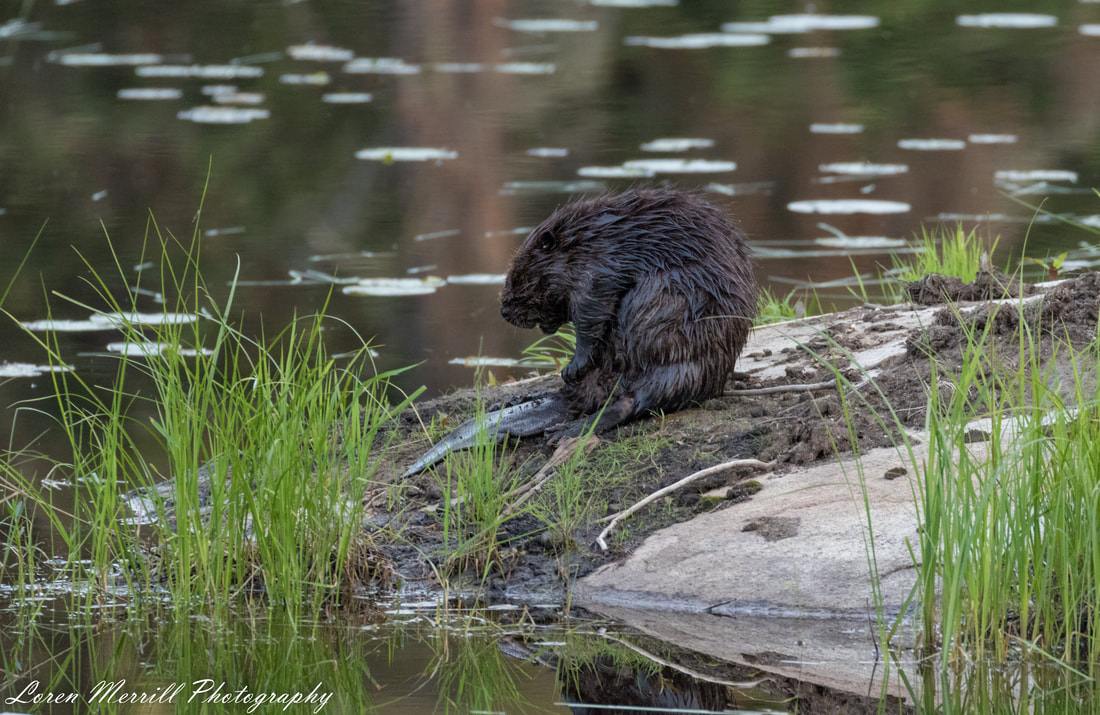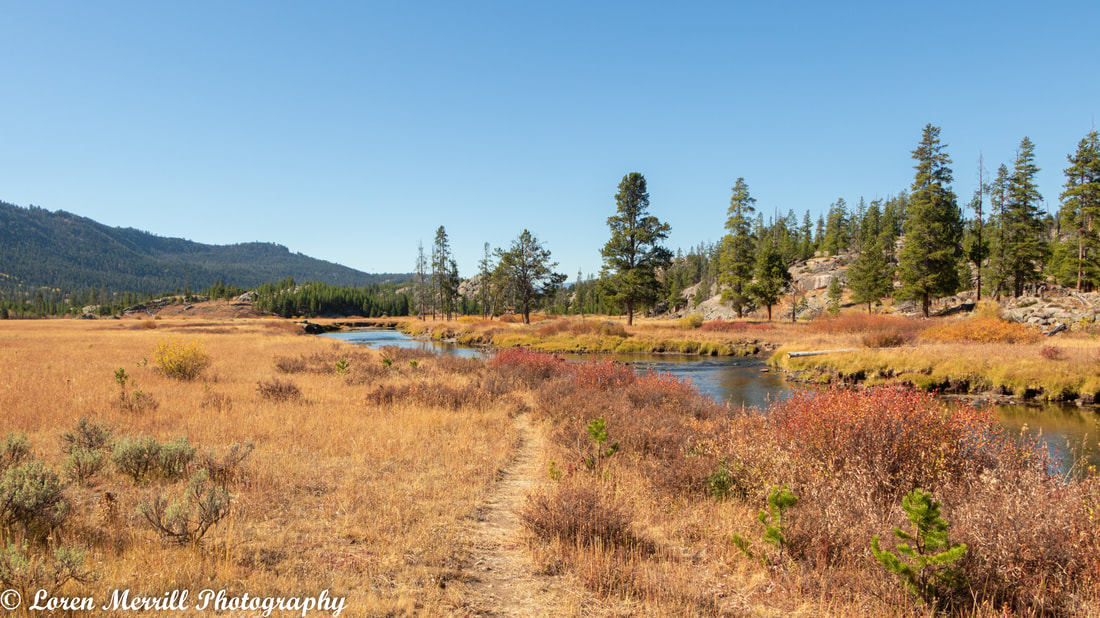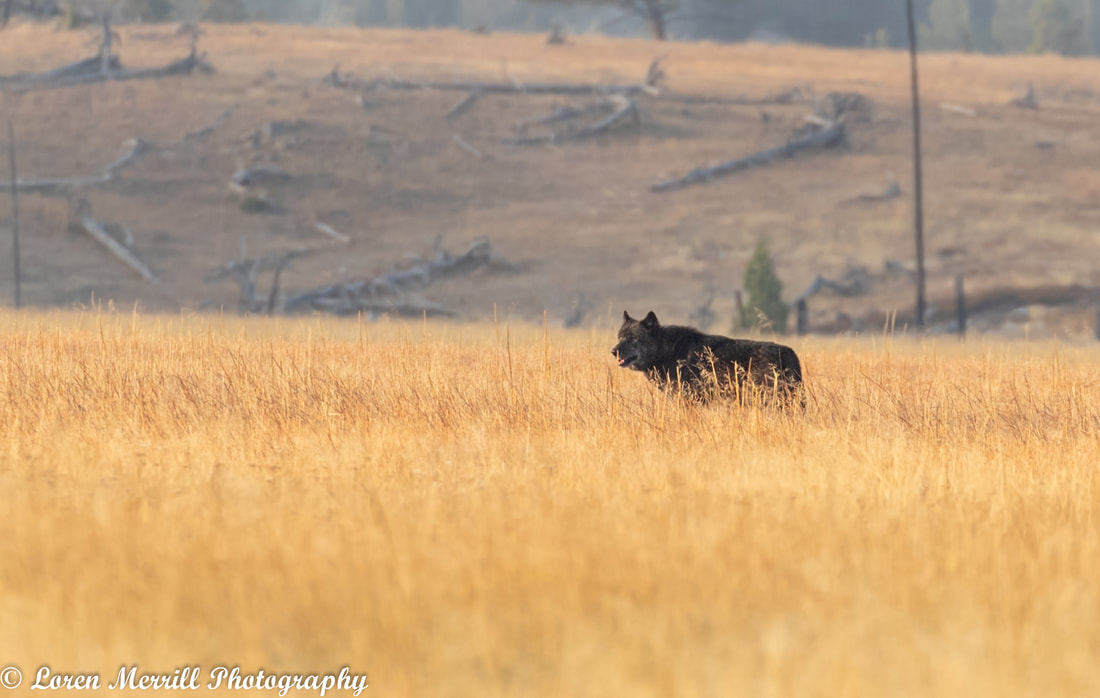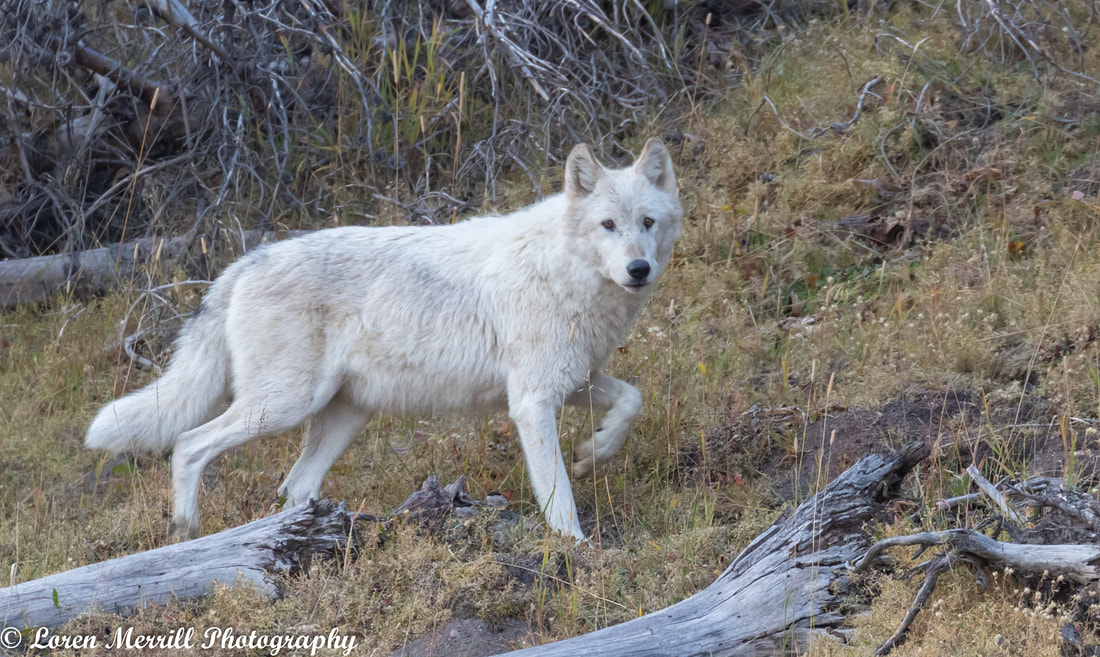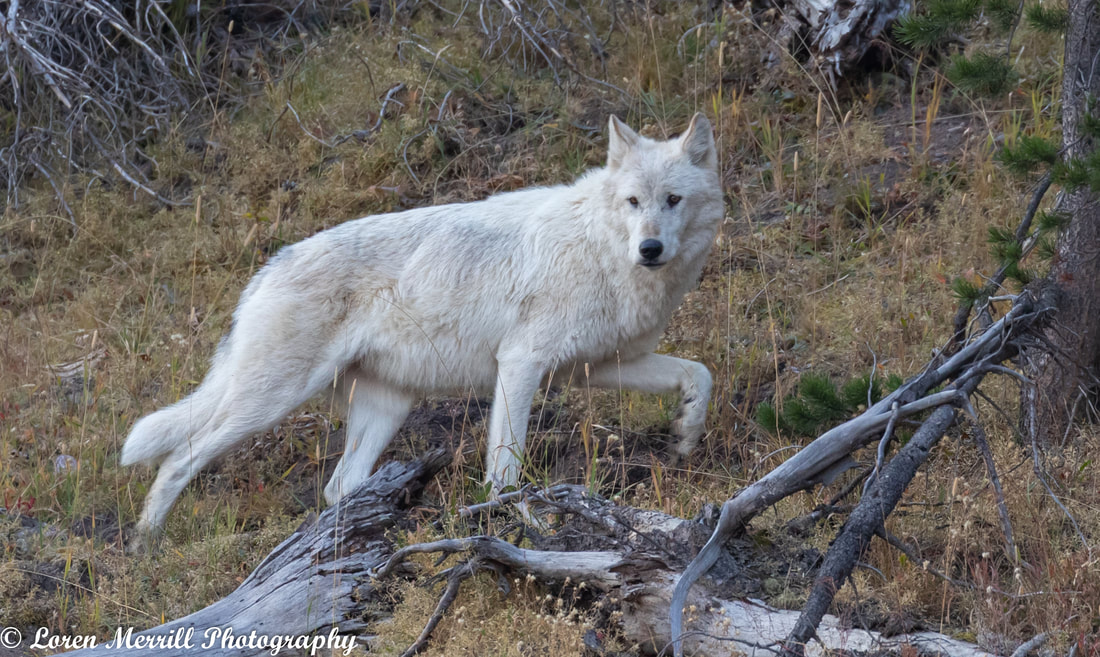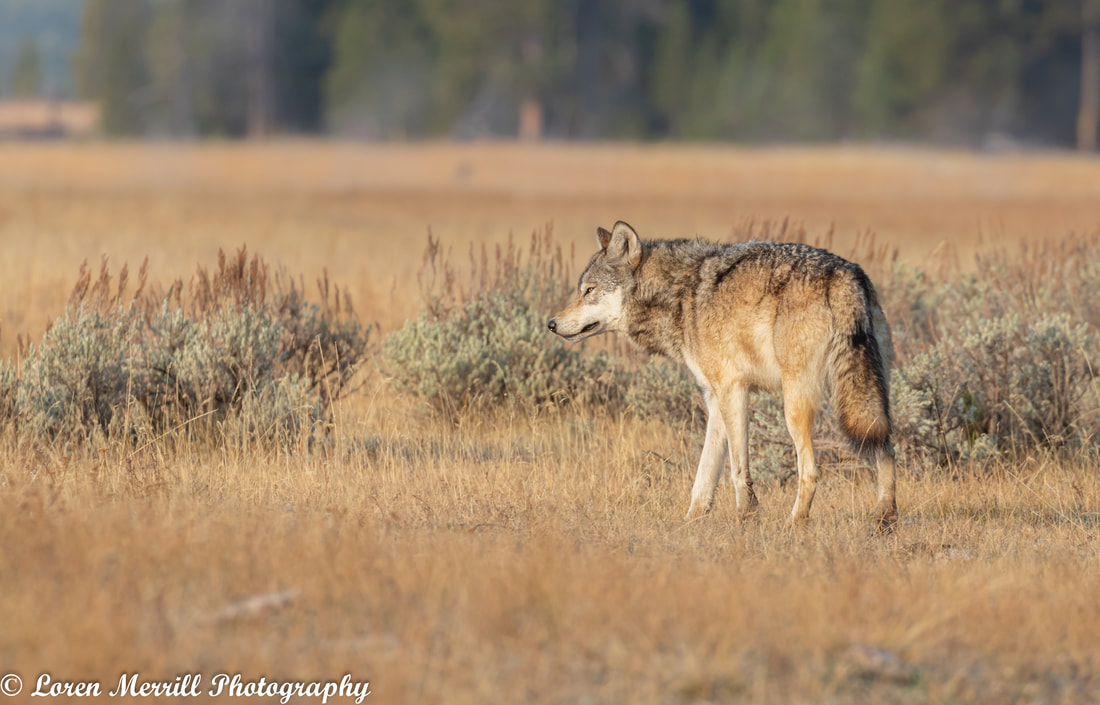|
The wolf materialized so silently from among the ponderosa pines, it was as though the trees had simply breathed it into existence. Everywhere around me within the Yellowstone Caldera, the land was exhaling- hydrothermal vents steamed, hot springs simmered, mud pools bubbled, and geysers erupted- but when I spotted the large canine trotting out into the sagebrush just 25 feet away from me, my breathing paused for a second. This was a moment I had been waiting years for; a close encounter with a wolf in the wild. And while wolves are one of Yellowstone’s big attractions these days, a little over a quarter century ago, there were no resident wolves in the park. Historically, wolves occupied the vast majority of North America, with an estimated 2 million animals roaming from northern Canada and Alaska down into Mexico. But an aggressive (and federally funded) eradication campaign resulted in the extirpation of wolves from all of the lower 48 states, with the exception of small populations in Michigan and Minnesota, as well as a few individuals of the Mexican gray wolf subspecies in Arizona/New Mexico, and a few of the red wolf subspecies/species in Louisiana/Texas. In the 1960s, federal protection was granted for wolves in the lower 48, and in January 1995, 8 wolves from Jasper National Park, in Alberta, Canada were trucked down to Yellowstone National Park and released. These wolves were the first to set foot in the park since the 1920s, and over the next two years, they were joined by an additional 33 animals. During the next two and a half decades, the Greater Yellowstone ecosystem experienced some dramatic changes as the wolves established packs throughout the park and expanded into the surrounding areas. The return of the wolf had a very immediate and direct impact on two species that had become quite abundant during the wolf’s absence- elk and coyotes- and indirect effects on hundreds of other species. Wolves are both top predators and keystone species, and their return set-off a cascade of ecological events (called a “trophic cascade”), with ripple effects spreading to almost every habitat and community in the region. In the absence of wolves, elk numbers exploded, with upwards of 20,000 elk wandering inside the park’s boundaries. Wolves are the primary predator of elk, and without wolves to keep their population in check, elk levels far exceeded the area’s carrying capacity. This meant that during harsh winters, or periods of drought, thousands of elk could starve to death. Now, 25 years after the wolf reintroduction, elk numbers have stabilized at between 6,000 and 8,000 animals. Researchers who have been studying the ecological effects of the wolf reintroduction say elk no longer starve to death in appreciable numbers during the winter. Moreover, by keeping the elk population down and selectively killing individuals in poorer condition, the wolves may be creating elk herds that are more resilient to environmental variability. This could help elk populations cope with increased climatic volatility associated with climate change. Researchers also found that wolves changed their hunting behavior in response to environmental conditions. In years with normal amounts of precipitation, wolves target older female elk, which are the easiest to hunt. But during dryer years when forage is lower quality, wolves take a much higher percentage of bulls. Bull elk eat relatively little during the mating period, or “rut”, when they expend enormous amounts of energy battling for dominance. In years with reduced precipitation and poor-quality food, bulls can be especially vulnerable to predation. The impact of wolves on coyotes is no less striking than their effect on elk, but it occurred via competition rather than predation. Wolves are the primary competitors of coyotes, and with their larger, more dominant cousins out of the way, coyote numbers shot up in the park. While coyotes are unable to take down an adult elk, they fed on deer and the calves of many of the park’s ungulates. They also took advantage of the high number of winter-killed elk. When wolves returned, coyote numbers in some areas of the park declined by 50%. Wolves will kill coyotes in the same manner that lions seek out and try to kill leopards and cheetahs; eliminate the competition, and there will be more prey for you. Most of the coyotes that are killed by wolves these days are those that are not patient or wary enough at a kill site; a coyote that comes in to a wolf kill while the wolves are still feeding is unlikely to survive to the next breeding season. But what about the indirect effects that wolves have had on so many other species in the park? The high number of elk present before the wolf return resulted in overgrazing of many areas, especially the riparian zones bordering streams and rivers. Not only were there lots of hungry elk, but the elk would settle in an area and eat everything available. The loss or reduction of willow, aspen, cottonwood, and berry-producing shrubs from these habitats also negatively impacted bird species that use those trees and shrubs for nesting and food, as well as beaver, which depend on willows in the winter months. Beavers are themselves important ecological players, and their disappearance from the landscape resulted in largescale changes. Beavers are called “ecological engineers” because their damns create ponds and wetlands and alter the hydrology of streams and rivers. The habitats they create are important for a wide array of animals, from aquatic invertebrates, fish, and amphibians, to waterfowl and moose. The return of wolves has had a positive impact on the ecosystem in two ways: they’ve reduced the number of elk overall, and the elk that remain no longer settle in riparian zones and remove all the edible vegetation. The reason for the latter is that wolves often travel along streams and rivers, thereby providing a reasonably strong deterrent to the elk. This wolf-driven alteration in the elks’ behavior, and the landscape-level effects associated with it, is now referred to as a “landscape of fear.” Essentially, this means that in places where predators are present, their prey have to adjust their behavior to reduce the risk of predation. Usually this entails spending more time watching for predators (at the expense of time spent eating), and avoiding areas where the predator is likely to occur or where the prey cannot see the predator coming. Today, the Greater Yellowstone ecosystem much more closely resembles a healthy, intact ecosystem than it did prior to wolf reintroduction. Wolf numbers within the park rise and fall from year to year, but over the past decade have mostly fluctuated between 83 and 108 wolves. This past year there were about 95 wolves spread across eight packs. These packs are heavily monitored by wildlife biologists, and there is very high-resolution information about the genealogy of just about every individual in the park. In addition, biologists know much of the social structure of each pack, as well as the soap opera levels of drama that can occur. For example, in 2019, a subordinate female of the Junction Butte pack (found in the northern portion of the park) killed the pups of the alpha female, and the pack then raised the subordinate female’s pups. And in 2000, a group of subordinate females from the Druid pack (no longer in existence), formed an alliance, and in true coup d’etat fashion, killed the pack’s alpha female. Despite the death of the alpha female, the pack continued to raise her pups, albeit in a new den. The wolves of Yellowstone have acquired a bit of celebrity status, and people follow the trials and tribulations of the wolves in online forums, and at the park. When I was there in late September into early October, Lamar Valley was a hotbed of wolf-watching activity. Each morning and evening, when the wolves were more active, people would be lined up along the road by the hundreds. The focus of their attention was the Junction Butte pack, which had obligingly set-up on the other side of the valley. Most of the park’s wolf packs number between eight and 10 individuals, but the Junction Butte pack had 35 this year, 18 of which were born in 2020. People would bring lawn chairs, spotting scopes, and binoculars to watch the pack’s activity, and swap stories of the latest wolf gossip. One of the first things people notice about wolves within Yellowstone is the large number of wolves with black fur; in fact, almost 50% of the wolves are black. This color morph is linked to a single gene thought to have originated in domestic dogs from the Old World. North American wolves may have acquired this gene by hybridizing with domestic dogs brought over by people crossing the Bering Land Bridge within the last 7,000 years. Melanization (i.e. dark coloring) is linked to immune function in many species, from insects to mammals, and it appears that dark-colored wolves have better immune defenses against canine distemper (caused by a paramyxovirus), and may be more resistant to mange (caused by mites) than grey-colored wolves. Severe outbreaks of canine distemper (in 1995, 2005, and 2008) as well as mange (2007) may have selected for black-coated wolves within the park, and even throughout the Rockies. So why aren’t all the wolves in the park black now? It turns out that grey wolves tend to be more dominant during aggressive interactions, and grey-colored females tend to have larger litters than females with black fur. Grey individuals thus have greater fecundity (more offspring) when parasite and pathogen pressure are low, and black wolves have higher pup survival during disease outbreaks. In addition to the black and gray coloration, there are a few white wolves in the park. One of these is the alpha female of the Wapiti Lake wolf pack, and a few minutes before my interaction with the grey wolf described in the opening paragraph, I had come across this beautiful white wolf. My initial glimpse of her was at some distance, when I saw her padding along the edge of a large stream. I headed off in her direction, hoping to get some shots that would show something more than a dog-shaped dot on the horizon. I quickly lost track of her, however, due to the undulating nature of the terrain, and stopped to consider my options. I was about to head back towards my car, when I caught movement out of the corner of my eye. On a nearby wooded hill, a white shape was gliding among the trees. When she caught site of me, she paused, and after surveying the area, she loped off, disappearing over the hill’s ridge. I hurried back to the road, hoping to catch a glimpse of her as she entered the broad expanse of sagebrush, but I couldn’t see her anywhere. I looked out into the meadow and saw a massive black wolf trotting through the grass. He was joined by a much smaller grey wolf, and then the white wolf appeared, making for the black and grey members of the pack. It was at this moment that the grey wolf emerged from the pines just to my right, and began his foray out into the sagebrush. Instead of going directly to the other members of the pack, he instead turned part ways towards me and began howling. Hearing a wolf howl in the wild is a transcendent experience. For me, it encapsulates the soul of the wilderness. And having a wolf howl in such close proximity… well, it was indescribably powerful. And now, thanks to passage of a ballot initiative in the November 2020 election calling for the reintroduction of wolves in Colorado, this is an experience that people in the Colorado Rockies may be able to experience within a few years. The wolf, like so much of our world, has become politicized and polarized, and this was on full display leading up to the election. A deep-seated dislike of predators still permeates a large section of the population, especially among hunters and livestock owners. Hunters don’t like the competition, and livestock owners don’t like the risk to their livelihood. And both have valid concerns; elk numbers have dipped in places where wolves returned, and wolves do kill livestock. But perception and reality are not always linked. Wolves may decrease the number of elk, but wolves generally target older and weaker individuals, whereas hunters prefer healthy adults in their prime. Colorado has an estimated 287,000 elk, and wolf reintroduction could have a positive impact on the health of the elk population, similar to what has happened in Yellowstone. In addition, there likely will be ripple effects which may benefit hunters in the long term. Decreases in coyote numbers may lead to increased deer fawn survival, and reduced levels of overgrazing by elk and moose could benefit game birds like grouse and turkeys. With regards to livestock, verified depredation by wolves accounts for a fraction of a percent of livestock mortality, even across the northern Rocky Mountain range where wolves now live. By far the greatest causes of mortality are health and weather-related deaths. Does wolf-predation still affect the bottom line for livestock managers? For some, yes. Are there ways to mitigate this cost? Absolutely. This is part of what researchers and state officials will be working on as they develop a Colorado wolf reintroduction plan over the next three years. The wolves of Yellowstone have taught us an incredible amount about the importance of top predators to the health of an ecosystem. Now we just have to find ways to coexist with them. Next post: TBD.
Subscribe to the Newsletter! If you would like to get notifications about when new posts are up and other tidbits related to the blog, sign up for the View Out the Door twice-monthly newsletter. Just email viewoutthedoor “at” gmail “dot” com with the subject header SUBSCRIBE. And if you’d like to unsubscribe, e-mail with the subject header UNSUBSCRIBE.
0 Comments
Leave a Reply. |
About the author:Loren grew up in the wilds of Boston, Massachusetts, and honed his natural history skills in the urban backyard. He attended Cornell University for his undergraduate degree in Natural Resources, and received his PhD in Ecology from the University of California, Santa Barbara. He has traveled extensively, and in the past few years has developed an affliction for wildlife photography. Archives:
|
